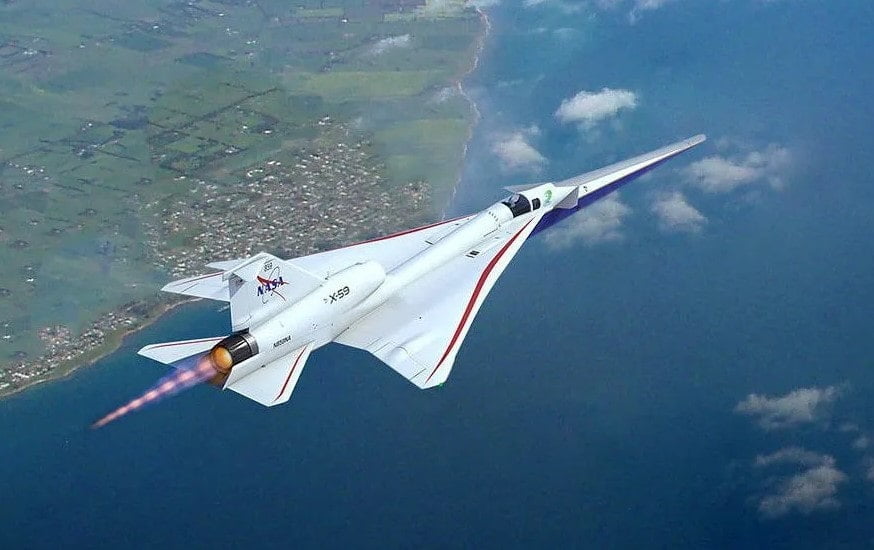NASA and Lockheed Martin Skunk Works are collaborating on the development of an experimental X-59 Supersonic Jet. The initial design work for this jet commenced in February 2016, aiming for the commencement of flight testing in 2021. However, due to delays, the current plan is for its inaugural supersonic flight to take place in 2024.
NASA’s Quesst mission revolves around the X-59, which Quesst stands for “Quiet SuperSonic Technology.” This mission aims to showcase the X-59’s ability to achieve supersonic flight without producing disruptive sonic booms. It will also assess public perceptions of the quieter sonic “thumps” generated during overhead flights. The feedback on these subdued sounds will be communicated to regulatory authorities, potentially influencing the formulation of new rules that could lift the current ban on supersonic flight over land.
The objective of the experimental X-59 Supersonic Jet

NASA’s X-59 project is on a mission to reshape the future of air travel by challenging the longstanding restrictions on commercial supersonic flights over land. For five decades, these flights have been banned due to the disruptive impact of thunderous sonic booms on communities below.
The X-59 aims to supply crucial data to regulators, encouraging a reconsideration of these rules. By collecting and sharing information on the aircraft’s noise profile, NASA hopes to demonstrate the feasibility of quiet supersonic travel, unlocking new opportunities for U.S. companies in the commercial aviation sector.
The innovative data and technology generated from this unique venture will be shared not only with regulators but also with the broader industry. As the X-59 soars over selected U.S. cities, NASA will engage with communities to gather valuable input on the perceived sound, paving the way for potential changes in regulations. Ultimately, NASA envisions a future where quiet supersonic travel becomes a reality, benefiting both American businesses and global travelers.
Design of X-59 Supersonic Jet
The X-59 Supersonic Jet stands out as a unique experimental aircraft, distinct from a conventional prototype, as its advancements are designed to pave the way for the next era of quiet supersonic planes. With dimensions measuring 99.7 feet in length and 29.5 feet in width, the aircraft boasts innovative features. The Quest team strategically positioned the single engine on top and ensured a smooth underside to prevent shockwaves from coalescing behind the plane, averting the typical sonic boom. A distinguishing characteristic is the slender, tapered nose, constituting almost a third of its length, specifically crafted to disperse shockwaves and mitigate the sonic boom effect.
It is powered by the F414-GE-100 engine, and the X-59 Supersonic Jet is projected to cruise at Mach 1.42, reaching speeds of 1,510 km/h (937 mph) at an altitude of 55,000 feet (16,800 meters). What sets this supersonic aircraft apart is its commitment to a low effective perceived noise level (EPNdB) of 75, akin to the sound produced by a closing car door. This endeavor aims to assess the acceptability of supersonic transport with minimal disturbance, showcasing NASA’s dedication to advancing air travel technology.
Configuration of X-59 Supersonic Jet
| Attribute | Data |
|---|---|
| Length | 99.7 feet |
| Width | 29.5 feet |
| Engine | F414-GE-100 |
| Speed (Cruising) | Mach 1.42 (1,510 km/h; 937 mph) |
| Altitude | 55,000 feet (16,800 meters) |
| Effective Perceived Noise Level (EPNdB) | 75 |
| Sonic Boom Prevention Features | Engine mounted on top, smooth underside, slender tapered nose |
| Max Design Gross Weight | 25,000 lbs |
| Empty Weight | 14,990 lbs |
| Fuel | 8,700 lbs |
| Payload | 600 lbs |
| Loudness | <75 PLdB |
| Landing Gear | F-16 Blk25 NLG, F-16 Blk25 MLG |
Read also After Ingenuity, NASA Plans to Send Giant Solar-Powered Plane ‘Maggie’ to Mars
Read also Indian Space startup building fuel station in Space!


